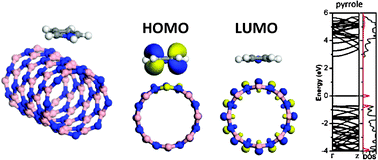Ab initio theoretical study of non-covalent adsorption of aromatic molecules on boron nitride nanotubes†
Abstract
We have studied non-covalent functionalization of

* Corresponding authors
a
Department of Chemistry and Nebraska Center for Materials and Nanoscience, University of Nebraska-Lincoln, Lincoln, Nebraska 68588
E-mail:
xczeng@phase2.unl.edu
b
CAS Key Lab of Materials for Energy Conversion, Department of Materials of Sciences and Engineering and Hefei National Lab for Physical Science at the Microscale, University of Science and Technology of China, Hefei, China
E-mail:
xjwu@ustc.edu.cn
c Department of Chemical Physics and Hefei National Lab for Physical Sciences at the Microscale, University of Science and Technology of China, Hefei, China
We have studied non-covalent functionalization of

 Please wait while we load your content...
Something went wrong. Try again?
Please wait while we load your content...
Something went wrong. Try again?
Y. Zhao, X. Wu, J. Yang and X. Cheng Zeng, Phys. Chem. Chem. Phys., 2011, 13, 11766 DOI: 10.1039/C1CP20534J
To request permission to reproduce material from this article, please go to the Copyright Clearance Center request page.
If you are an author contributing to an RSC publication, you do not need to request permission provided correct acknowledgement is given.
If you are the author of this article, you do not need to request permission to reproduce figures and diagrams provided correct acknowledgement is given. If you want to reproduce the whole article in a third-party publication (excluding your thesis/dissertation for which permission is not required) please go to the Copyright Clearance Center request page.
Read more about how to correctly acknowledge RSC content.
 Fetching data from CrossRef.
Fetching data from CrossRef.
This may take some time to load.
Loading related content
